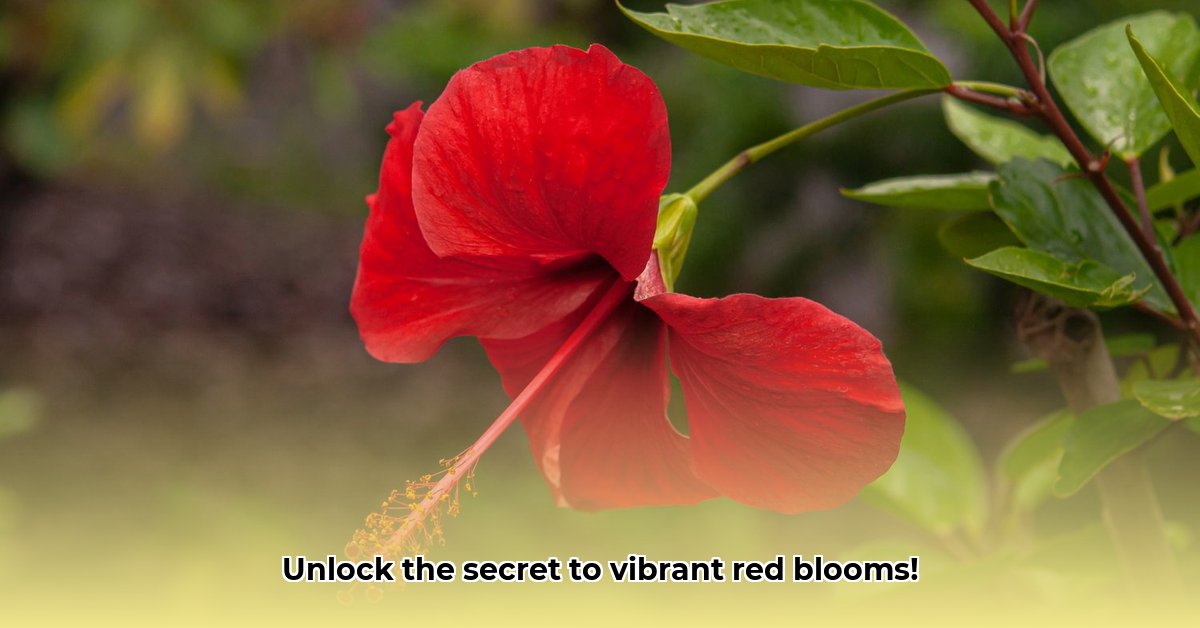Want a garden that pops with vibrant red flowers? This guide will show you how to grow gorgeous red flowers, whether you’re a pro or just starting out. We’ll cover everything from picking the perfect plants to keeping them healthy and blooming beautifully. We’ll even talk about attracting helpful pollinators like bees and butterflies! Ready to learn the secrets to a stunning, red-hot garden? Let’s get growing!
Grow Stunning Red Flowers: A Complete Guide
Embark on a vibrant journey into the world of red flowers! From the delicate blush of a poppy to the bold, commanding crimson of a rose, there’s a perfect red bloom waiting to grace your garden. This guide will lead you through choosing, planting, and nurturing these fiery beauties, transforming your outdoor space into a breathtaking spectacle of color.
Choosing the Right Red Flower for Your Garden
Selecting the perfect red flower is a delightful adventure. The key lies in understanding your gardening style and the conditions in your garden. Do you prefer a dramatic, eye-catching display or a more subtle, elegant touch? Are you a seasoned gardener or just starting out? And perhaps most importantly, how much sun does your garden get? Different red flowers have different needs, like whether they require lots of sunlight or thrive in the shade.
Let’s explore some popular choices to get you started:
Annual Red Flowers: A Burst of Summer Color
Annuals are your go-to option for instant gratification. These beauties bloom profusely throughout the growing season, providing a vibrant splash of color—perfect for adding quick, dazzling impact to any area. Think of the cheerful scarlet salvia, with its tall spires of vibrant red, or the dazzling array of red zinnias in various shapes and sizes. They’re relatively low-maintenance and offer incredible versatility. Did you know that annual red flowers are perfect for adding pops of color to garden beds and containers? Consider varieties like:
- Scarlet Salvia (Salvia splendens): Known for its upright spikes of vibrant red flowers, attracting hummingbirds and butterflies.
- Red Zinnia (Zinnia elegans): Offers a wide array of shapes and sizes, providing continuous blooms throughout the summer.
- Red Geranium (Pelargonium x hortorum): A classic choice for containers and borders, offering bright, long-lasting color.
Perennial Red Flowers: Year After Year Beauty
For long-lasting beauty and minimal effort, perennial red flowers are the champions. These reliable performers return year after year, becoming steadfast companions in your garden. Imagine the striking elegance of a red coneflower (Echinacea), attracting beneficial pollinators with its daisy-like blooms, or the classic beauty of the red daylily, known for its profusion of blooms throughout the summer. These steadfast plants require less attention compared to annuals, offering consistent color throughout the seasons. Did you know that perennial red flowers are a sustainable option for adding beauty to any garden, year after year? Explore options like:
- Red Coneflower (Echinacea purpurea): A hardy perennial that attracts pollinators and offers medicinal benefits.
- Red Daylily (Hemerocallis): Known for its easy care and profusion of blooms, offering a wide range of red shades.
- Cardinal Flower (Lobelia cardinalis): A native perennial that thrives in moist areas and attracts hummingbirds with its vibrant red spikes.
Shrubby Red Flowers: Adding Structure and Depth
If you’re looking to add architectural interest and long-lasting color to your garden, consider planting red flowering shrubs. These provide a structural element, offering a framework for other plants to flourish around. The fiery blooms of a red potentilla, a low-maintenance shrub with bright red flowers all summer, or the deep red blooms of a weigela, known for its striking bell-shaped flowers in spring and summer, can add incredible depth and seasonal interest to your landscape. Shrubby red flowers add structure and depth, enhancing your landscape’s overall appeal. Consider these varieties:
- Red Potentilla (Potentilla fruticosa): A low-maintenance shrub with bright red flowers throughout the summer.
- Weigela (Weigela florida): Known for its striking bell-shaped flowers in spring and summer, offering deep red blooms.
- Red Azalea (Rhododendron): Provides vibrant color and evergreen foliage, adding structure and interest to the landscape.
Planting Your Red Flowers: A Step-by-Step Guide
Planting your red flowers should be a simple and enjoyable process. Follow these steps for best results:
- Soil Preparation: Healthy soil is crucial. Before planting, enrich your soil with compost or other organic matter. This improves drainage, introduces beneficial microorganisms (microscopic organisms in the soil), and provides essential nutrients for vigorous growth. Aim for a well-draining soil with a slightly acidic to neutral pH (6.0-7.0).
- Smart Spacing: Avoid overcrowding! Check the plant tags for recommended spacing. Giving each plant enough room allows for optimal root development and air circulation, reducing the likelihood of disease and promoting robust growth. Generally, space annuals 6-12 inches apart, perennials 12-24 inches apart, and shrubs according to their mature size.
- Deep Watering: A thorough watering after planting helps settle the roots and ensures a strong start. Consistent watering, especially during dry periods, is crucial, particularly for freshly planted flowers. Aim to water deeply but infrequently, encouraging deep root growth. Water at the base of the plant to avoid wetting the foliage, which can lead to fungal diseases.
- Mulching Magic: Apply a layer of mulch around your plants. Mulch acts as a protective blanket, helping retain moisture, suppress weeds, regulate soil temperature, and even improve soil structure over time. Use organic mulches like wood chips, shredded bark, or straw.
- Feeding Your Flowers: Regular fertilization provides essential nutrients for healthy growth and abundant blooms. Use a balanced, slow-release fertilizer according to the package directions, avoiding over-fertilization which can harm your plants. For annuals, fertilize every 4-6 weeks during the growing season. Perennials and shrubs can be fertilized in early spring.
Maintaining a Thriving Red Flower Garden: Ongoing Care
Consistent care is key to keeping your red flowers thriving! Here are some tips to help your blooms reach their full potential:
- Deadheading: Regularly remove spent blooms (deadheading). This encourages continuous flowering, prevents self-seeding, and maintains the overall aesthetic appeal of your garden. Pinch off the flower heads just below the bloom, encouraging new growth and more flowers.
- Pruning: Pruning your shrubs helps maintain their shape, size, and health. Remove any dead, diseased, or damaged branches to promote healthy growth. The timing of pruning will largely depend upon the type of shrub. Spring-blooming shrubs should be pruned immediately after flowering, while summer-blooming shrubs can be pruned in late winter or early spring.
- Pest and Disease Monitoring: Regularly inspect your plants for signs of pests or diseases. Addressing any issues promptly is crucial for preventing widespread damage. Many organic pest control solutions are available; alternatively, consult your local garden center for advice. Common pests include aphids, spider mites, and Japanese beetles. Diseases can include powdery mildew, black spot, and rust.
- Watering Wisely: Adjust your watering schedule based on weather conditions. During hot, dry spells, more frequent watering may be required. Use a soaker hose or drip irrigation to deliver water directly to the roots, minimizing water loss and reducing the risk of foliar diseases.
- Soil Testing: Periodically test your soil to monitor pH and nutrient levels. This will help you fine-tune your fertilization and soil amendment practices, ensuring optimal plant health.
Red Flower Variety Comparison: A Quick Guide
This table provides a general overview of some popular red flowers. Keep in mind that these characteristics can be influenced by specific conditions such as soil type, climate, and overall care.
| Red Flower | Height (inches) | Sun Exposure | Bloom Time | Hardiness Zone | Water Needs |
|---|---|---|---|---|---|
| Zinnia (Annual) | 12-36 | Full Sun | Summer | 2-11 | Moderate |
| Salvia (Annual) | 12-24 | Full Sun | Summer | 7-10 | Moderate |
| Daylily (Perennial) | 18-36 | Full Sun/Part Shade | Summer | 3-9 | Moderate |
| Coneflower (Perennial) | 24-36 | Full Sun | Summer/Fall | 3-9 | Low |
| Weigela (Shrub) | 36-72 | Full Sun/Part Shade | Spring/Summer | 4-8 | Moderate |
| Rose (Shrub) | 24-72+ | Full Sun | Spring/Summer/Fall | 3-11 | High |
| Begonia (Annual) | 6-12 | Part Shade | Summer/Fall | 9-11 (Grown as Annual) | Moderate |
Remember, gardening is a rewarding journey of learning and discovery. Embrace experimentation, learn from your experiences (both successes and setbacks), and enjoy
- Gray Kitchen Backsplash Tile: Ideas for a Stylish Upgrade - December 14, 2025
- Backsplash For Gray Cabinets: Choosing the Right Backsplash Style - December 13, 2025
- Gray And White Backsplash: Ideas For Timeless Style - December 12, 2025









